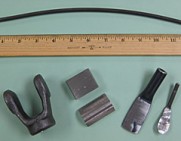
How big must the sample be for Atomic Emission Spectroscopy?
Ideally a sample for chemical analysis by atomic emission spectroscopy (AES) should be at least 1’ square and 0.050’ thick to prevent leaking of light and gas from the aperture during excitation and to prevent the sample from melting during excitation. AES samples of other configurations may be used if they can be mechanically altered to conform to this size requirement:
- Tubing with a 0.040” wall thickness or better and bar or rod down to 0.25” diameter can be flattened to yield a suitable AES sample. Similarly Round Pipe can be flattened to an accommodating flatness.
- Shaped samples may also be flattened for chemical analysis by atomic emission spectroscopy, if they will yield a sample of appropriate size.
 There are circumstances which will not allow a sample to be flattened, some of these are hardness, carburization, nitriding, and brittle alloys.
There are circumstances which will not allow a sample to be flattened, some of these are hardness, carburization, nitriding, and brittle alloys.
How much weight do I need for ICP-AES Carbon/Sulfur/Nitrogen analysis?
The required weight for Inductively-Coupled Plasma Atomic Emissions Spectroscopy (ICP-AES) carbon/sulfur/nitrogen analysis will depend on the sample and material being tested. Generally, we would like to have at least 5 grams of material for ICP-AES analysis, which is the weight of a nickel. Whenever possible, more is better, to have extra material for rechecks, if a material is found to be out of specification, or for re-sampling, if a problem is encountered during sample preparation.
The sample can be a powder, several small parts (e.g. screws, nuts, springs), or a machining product such as chips or drillings. If the sample is to be a machining product, care must be taken to provide only the material to be tested.
- Paint and corrosion as well as scale from the surface of parts should not be allowed to co-mingle with the sample, as this will lead to erroneous results.
- Large amounts of cutting oil should be avoided.
- Over heating the sample, resulting in blue or heat tinged chips can lead to false readings, especially in elements like carbon and sulfur.
The sample should be placed in a container that will not allow the sample to be lost in transit. Plastic bags with a seal lock are especially good for this, particularly for powders. If using plastic bags be sure the sample is cool before placing it in the bag.
Related Articles
Introduction to the ASTM E606 Standard
Low-Cycle Fatigue Testing and the Standards Set Forth by ASTM In the world of engineering, materials are often subjected to…
The Top 5 Consequences of Industrial Operations Not Calibrating Their Equipment
In the fast-paced world of industrial operations, precision is not just a goal—it’s a necessity. Calibration of equipment, a process…
The Benefits of Choosing a Calibration Company that Offers Instrument Replacement and Purchasing Services
In the demanding world of industrial manufacturing and quality assurance, selecting the right calibration partner can significantly impact your operational…
How Small a Defect Can UT Find
Customers often ask LTI how small a defect ultrasonic testing (UT) can find. This question is very difficult to answer…
Ethics in Laboratory Testing
What could be more important than ethics in the world of materials testing? Testing laboratories have an obligation to adhere…
Quality Considerations in Chemical Analysis
A Well-Planned and Managed Quality Control Program When you need chemical analysis services, you expect to receive accurate testing and…
